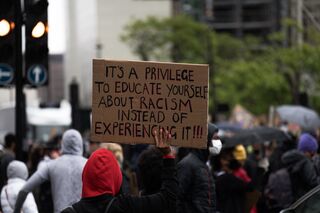Bias
Racism Goes Way Beyond White Supremacy
How racism hides, especially from those in power.
Posted November 22, 2020 Reviewed by Lybi Ma

I thought I knew a lot about racism. From the age of 4½, I had experienced it daily throughout elementary school in the playground. I couldn’t run away and I was too small to fight kids bigger than me. And, the teachers did nothing.
What I suffered then is overt racism. I only learned much later that racism in the United States is systemic, manifesting with both overt and covert behaviors. It is established and perpetuated in our formal institutions and informal socialization.
In the early 1990s, I contracted with AT&T as a diversity consultant to facilitate required affirmative action workshops for upper management. We dealt with issues related to racism, sexism, and LGBTQ (labeled then as “homophobia”) in the workplace and how they adversely impacted AT&T’s monetary value.
This was not a didactic workshop, with me standing up and lecturing. It was designed with exercises to highlight the “blind spots” we all have, especially about racism. Blind spots denote “what we don’t know that we don’t know.”
The workshops lasted three days, 10 hours a day, and were held off-site. Participants were not allowed to receive messages or make phone calls except during breaks. My territories were on the East Coast and Midwest for about five years, with approximately 30 to 35 managers per class, averaging 4 to 6 workshops a month.
In my time there, none of the participants, regardless of race, understood that racism was endemic in our nation—that it is legitimized in policies and laws, that it is unconsciously spread in our socialization, and that it pervades major institutions—finance, education, health, criminal justice, labor, etc. And, all these institutions impact our quality of life.
What Is Systemic Racism?
Regardless of color, most peoples’ connotation of racism applies only to white supremacists or bigots. This is the extreme form of overt racism and not the only factor that constitutes racism. It is, actually, the combination of both overt and covert applications that perpetuates racism today. The following is Merriam-Webster’s changed current definition:
...."a belief that race is the primary determinant of human traits and capacities and that racial differences produce an inherent superiority of a particular race.”
a: doctrine or political program based on the assumption of racism and designed to execute its principles
b: a political or social system founded on racism
racial prejudice or discrimination.
The following paraphrases the working definition AT&T used in the 1990s:
Racism is one group having power over another based on skin color. This gives the group in power the legal, political, and social sanctions to prevent the lower groups from equal access to goods and services afforded to the former.
The first exercise in the workshop was for participants to define racism. No one, again regardless of race, came up with the word “power.”
Since these workshops were geared for upper management, it’s no surprise that the majority of the participants were white males. The attendance of white women was much smaller, and for people of color, scarcer still.
Once the word “power” was introduced, the POCs, based on personal experience, understood their lack of it. The white women and LGBTQ groups understood it from their personal experiences with sexism and homophobia. But the white men, from my observation over five years of experience, were in shock. This was followed by denials that they were not racist, that they have Black, Brown, or Asian friends, that they have biracial relatives, etc.
The white managers had no idea that they could be racist simply by living in a nation whose policies and laws afforded them advantages that POCs didn’t have. To defuse their resistance to the idea, I asked them, “Let’s say that, as a Chinese-American woman, I am prejudiced against all white people. Based on AT&T’s definition of racism (see above), what power do I have to say where you can live, where you can go to school, what quality of healthcare you can receive, or prevent you from high paying jobs with advancement opportunities?” No one answered, but their facial and body language showed me that their resistance had lessened, whether they liked the example or not. Still, we had a long way to go.
Another exercise was to separate the white participants from the POCs and to have each group answer the same questions below, then return to the larger group and write the responses on the whiteboard.
Growing up, what messages did you receive about yourself as white or POC?
Growing up, what messages did you receive about the other group?
To their surprise, all the responses were basically the same.
Whites and POCs both came up with the following for the white group: beautiful, smart, successful, powerful, etc.
Whites and POCs both came up with the following for POCs: ugly, stupid, lazy, dangerous, etc.
This specific exercise shows that racism socializes us all to “know our place” by using the same stereotypes for each group. For a nation that, on the surface, proclaims equal opportunity for all, we are actually stereotyped at a very young age, as I was, indicating where each group belongs in this nation’s hierarchy. Where we "belong," then, influences the benefits or lack thereof that we receive.
Racism continues because it is hidden, especially from those in power who have the wherewithal to establish and execute policies that cause inequality based on skin color. Because there is formal and informal segregation based in neighborhoods, schools, etc., many in the upper echelons of the hierarchy do not have much contact with the poorer sections. It is due to both overt and covert systemic racism that inequality can continue.
What is hidden cannot be changed. Until the existence of systemic racism is acknowledged and accepted, it cannot and will not be eradicated. Until that occurs, it will be difficult, if not impossible, to form a society that affords equal opportunity for all.
References
Sign up for my newsletter to get notified about my future posts or email me at info@gayook.com to request a blog topic.
1. Cineas, Fabiola, Merriam-Webster Has A New Definition of Racism: The Revised Definition Will Include Systemic Oppression, vox.com, June 10, 2020.




